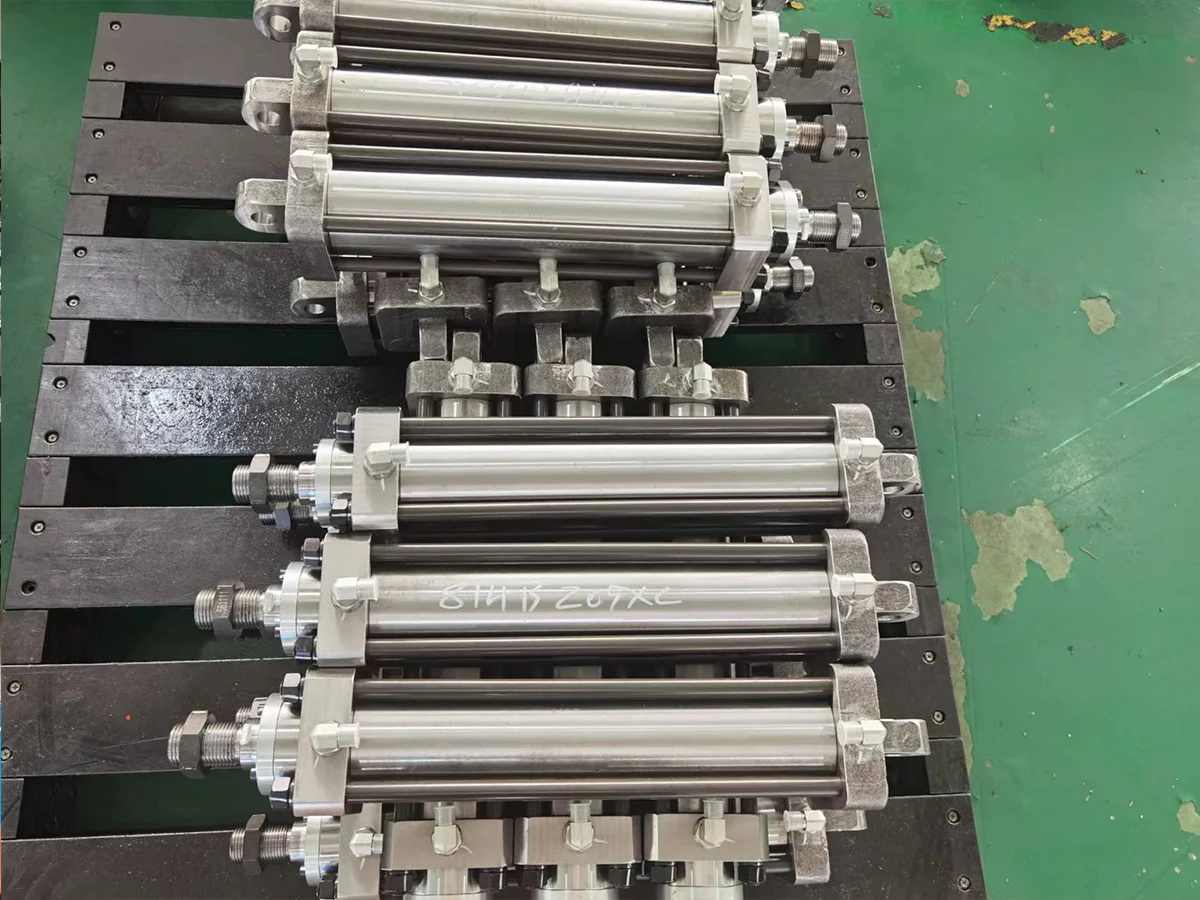- This topic is empty.
-
AuthorPosts
-
2025-06-23 at 11:44 am #9258
In modern industrial production, hydraulic systems, as an important way of power transmission and control, are widely used in many industries such as engineering machinery, agricultural equipment, mining machinery, metallurgical equipment, etc. In hydraulic systems, welded hydraulic cylinders have become key actuators for many equipment due to their compact structure, good pressure bearing performance, strong sealing, and relatively low manufacturing cost.
For purchasers or equipment manufacturers, price is always one of the core factors to pay attention to when selecting welded hydraulic cylinders. So, what are the factors that affect the price of welded hydraulic cylinders? Why are the quotations of different manufacturers or customized parameters for hydraulic cylinders with the same welded structure so different? This article will deeply analyze the key influencing factors of the price formation of welded hydraulic cylinders from multiple dimensions.
1. Cylinder material and processing technology
1.1 Material type
The cylinder body and cylinder head of welded hydraulic cylinders usually use seamless steel pipes or high-strength alloy steel. The type of material directly affects its pressure resistance, corrosion resistance and service life. Common materials include:
20# seamless pipe (conventional engineering machinery applications)
45# steel (higher strength)
Stainless steel (suitable for corrosive environments)
Alloy steel (for high pressure and high load applications)
The unit price of stainless steel and alloy steel is much higher than that of ordinary carbon steel. If the customer's equipment has special requirements for corrosion resistance or high pressure bearing, the overall cost of the hydraulic cylinder will inevitably increase.
1.2 Material size and wall thickness
The larger the inner diameter of the cylinder and the thicker the wall, the more material is used, and the processing difficulty increases accordingly. For example, a hydraulic cylinder with a cylinder diameter of 200mm and a wall thickness of 25mm has a much higher material cost and processing requirements than a product with a cylinder diameter of 100mm and a wall thickness of 10mm.

2. Piston rod design and surface treatment
2.1 Rod diameter and length
The diameter and length of the piston rod not only affect the force performance, but also determine the material cost. For example, under the same stroke, if the piston rod diameter increases from Φ40 to Φ60, the material weight will increase significantly.
2.2 Surface plating treatment
The piston rod usually needs to be chrome-plated to improve wear resistance and corrosion resistance. The standard chrome plating thickness is 20~30μm, but some industries (such as marine machinery and garbage compression equipment) may require thicker chrome plating or nickel plating, resulting in higher costs.
3. Sealing system configuration
The sealing performance of the welded hydraulic cylinder is directly related to the stability and service life of the equipment. The brand, structure and material of the selected seal will significantly affect the price.
3.1 Seal brand
Common brands include PARKER, NOK (Japan), Merkel (Germany), Hallite (UK), etc. The unit price of imported seals is much higher than that of domestic products, but they perform better in high temperature resistance and pressure resistance.
3.2 Sealing structure design
Multi-stage sealing, composite dust ring or high-frequency leak-proof structure design will significantly increase the difficulty and cost of manufacturing, especially in complex working conditions, where customized sealing solutions are required.
4. Stroke and cylinder diameter size
The working stroke and cylinder diameter of the hydraulic cylinder are the basic parameters that affect the price.
4.1 The longer the stroke, the higher the cost
Long stroke means that the piston rod length increases and the cylinder barrel is also longer, which increases the processing difficulty and transportation cost.
4.2 Large cylinder diameter needs to be customized
Hydraulic cylinders with large cylinder diameters (such as Φ250 and above) are usually not suitable for mass production. They need to customize the cylinder barrel and flange interface, which requires high processing equipment and significantly increases the unit cost.
5. Pressure level and operating conditions
5.1 Rated working pressure
Common pressure levels for welded hydraulic cylinders are:
16MPa (light industrial equipment)
25MPa (construction machinery)
32MPa and above (heavy load operation)
The higher the pressure level, the higher the requirements for weld quality, material strength, and sealing. The required inspection process (such as X-ray flaw detection and ultrasonic inspection) is also more complicated, and the price naturally rises.
5.2 Impact of the use environment
If the hydraulic cylinder needs to be used in high-temperature, extreme cold, and highly corrosive environments, additional anti-corrosion coatings, special sealing improvements, or material upgrades are required. For example:
Salt spray resistant spraying process
Special low temperature sealing ring (-40℃~)
Explosion-proof grade design, etc.
These special working conditions have a significant impact on the price.
6. Installation structure and interface method
Common installation methods for welded hydraulic cylinders include earring type, flange type, pin type, front and rear cover connection type, etc. Complex installation structures require customized processing, which has the following impacts on the price:
Flange interface: high-precision flange surface needs to be processed, and the price is relatively high;
With buffer device: the cylinder with adjustable buffer structure requires additional complex machining, and the price is higher;
Multi-interface structure: if the hydraulic cylinder requires multiple oil ports or quick connectors, it also increases the manufacturing difficulty and material cost.
7. Customization degree
The price of standard parts is usually low. If the customer proposes personalized customization requirements, such as:
Special installation size
Stroke sensor integration
Special oil port thread or rotary joint
Built-in buffer or stroke control device
The manufacturing process becomes complicated, and it is necessary to re-open the mold, debug, or even produce one piece, which significantly increases the cost.
8. Bulk purchase and production cycle
8.1 Purchase quantity
Bulk purchase can significantly reduce unit cost, because raw materials can be purchased in batches, machining equipment can be produced in batches, and labor costs are amortized. For example:
Single-piece customization: The price is relatively high
Batch of more than 50 sets: The price can be discounted by 10~30%
8.2 Delivery time requirements
If the customer has urgent needs, overtime work or inserting orders for production will also increase the quotation.
9. Manufacturer brand and service level
The product prices of well-known hydraulic cylinder brand manufacturers are generally higher than those of small and medium-sized processing plants. This is not only reflected in product quality and manufacturing process, but also includes:
Whether to provide complete drawing design
Whether to support after-sales technical services
Whether to have third-party testing and certification (such as ISO, CE)
Whether to support warranty period (generally 12~18 months)
Although these services increase costs, they can reduce the risk and maintenance expenses of customers in later use.
The price of welding hydraulic cylinders is not determined by a single factor, but the result of multiple dimensions. From raw material selection, processing technology, sealing system, to structural design, use environment, and degree of customization, these are the core factors that affect the final quotation.
For purchasers, product performance, service life, stability and after-sales service should be considered comprehensively. High-quality welding hydraulic cylinders can not only reduce equipment failure rate, but also significantly reduce maintenance costs in long-term operation, achieving optimal cost performance.
If you are looking for a reliable welding hydraulic cylinder supplier, it is recommended to communicate with professional manufacturers about demand parameters, obtain customized quotations and technical solutions, and choose product solutions that are more suitable for your working conditions and budget.
If you need to know more about the selection, customization process, installation method or price calculation method of welding hydraulic cylinders, please contact us for more professional advice and technical support.
http://www.toringcylinder.com
toringcylinder -
AuthorPosts
- You must be logged in to reply to this topic.
